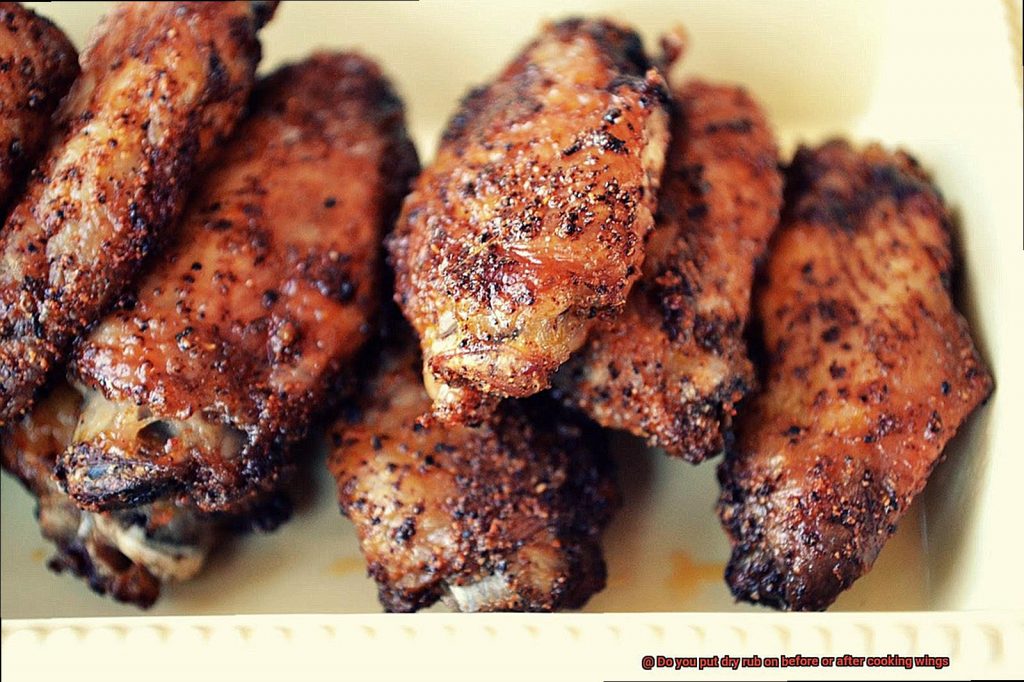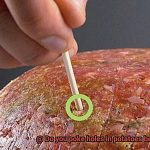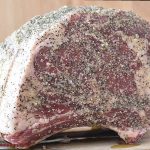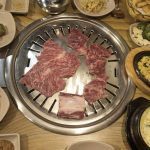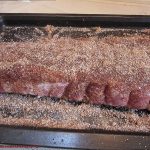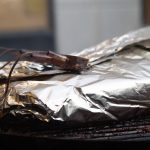Hey there, fellow chicken wing enthusiasts. Are you ready to dive into the age-old debate of when to apply dry rub on your wings? As someone who has spent countless hours experimenting with different flavor combinations, I can confidently say that this is a question worth exploring.
Picture this: it’s game day and you’re in charge of making the wings. You’ve got your favorite dry rub recipe ready to go, but you’re not sure if you should put it on before or after cooking. The stakes are high – nobody wants bland or over-seasoned wings.
Dry rubs are a fantastic way to add complexity and depth to your chicken wings. Whether you prefer a spicy kick or something sweet and tangy, the right combination of spices can take your wings from good to great. But the million-dollar question remains: before or after cooking?
Some swear by applying the rub before cooking, claiming that it allows the flavors to penetrate deeper into the meat. Others argue that adding the rub after cooking creates a crispier texture and prevents burning.
So, what’s the verdict? In this post, we’ll explore both sides of this debate and provide some helpful tips for achieving perfectly seasoned wings every time. Whether you’re a seasoned chef or just starting out in the kitchen, keep reading to find out if you should put your dry rub on before or after cooking your wings.
Contents
Factors to Consider When Applying a Dry Rub
When it comes to cooking wings, a perfectly seasoned and flavorful dry rub can make all the difference. However, applying a dry rub can be a tricky process. There are several factors to consider, including the texture of the rub, the cooking method, the type of rub being used, and personal preference.
To begin with, let’s talk about what a dry rub is and how it works. A dry rub is a mixture of herbs, spices, and other ingredients that are rubbed onto the surface of the meat before cooking. The goal is to create a flavorful crust that enhances the texture of the meat.
One essential factor to consider when applying a dry rub is its texture. If the rub has large chunks of herbs or spices, it’s best to apply it before cooking the wings. This way, the flavors can penetrate the meat and create a deeper flavor profile.
The next factor to consider is your cooking method. If you’re grilling or smoking your wings, it’s best to apply the dry rub before cooking. This will give your rub time to form a delicious crust on the outside of the wings and create a smoky flavor that will make your taste buds dance.
However, if you’re baking or air frying your wings, it’s best to apply the dry rub after cooking. This will prevent your rub from burning or becoming too charred during the cooking process.
It’s also important to pay attention to the type of dry rub you’re using. Some rubs contain a lot of salt, which can draw moisture out of the meat and leave it dry. If you’re using a salt-heavy rub, it’s best to apply it after cooking so that it doesn’t have as much time to draw out moisture.
Last but not least, personal preference plays an essential role in when to apply a dry rub. Some people prefer a more intense flavor and may choose to apply their rub before cooking, while others may prefer a milder flavor and opt for applying it after cooking.
In conclusion, applying a dry rub to wings is all about finding what works best for you and your taste buds. Experiment with different textures, cooking methods, types of rubs, and timing until you find the perfect combination that elevates your wings to new heights of deliciousness.
To sum up, here’s a list of factors to consider when applying a dry rub:
- Texture of the rub
- Cooking method
- Type of rub being used
- Personal preference
Applying the Dry Rub Before Cooking
Elevate your wing game by applying a flavorful dry rub before cooking. This technique is a popular way to enhance the taste and texture of wings, creating a mouth-watering crust that will satisfy your cravings.
To start, gather your desired spices and herbs. Whether you prefer a classic BBQ rub or something with a little more kick, the options are limitless. However, it’s best to avoid rubs with high sugar content as it can lead to burnt wings.
After selecting your rub, it’s time to apply it to the wings. Begin by patting the wings dry with paper towels to allow the rub to adhere better to the meat. Next, generously sprinkle the rub over all sides of the wings, ensuring an even coating. You can also use your hands to massage the rub into the meat for maximum flavor infusion.
For an even more delicious outcome, let the wings rest in the fridge for a few hours or overnight. This step allows time for the flavors of the rub to seep into the meat, producing an exceptional result. However, if you’re short on time, you can still cook them immediately after applying the rub.
It’s essential to remember that when using a dry rub, it’s best to skip additional sauces or marinades. These additions can overpower and mask the flavors of your hard work. Instead, serve your wings with a simple dipping sauce or enjoy them as they are.
Advantages of Applying the Dry Rub Before Cooking
Look no further than applying a dry rub before cooking. As an expert on this topic, I can attest that there are several advantages to using a dry rub on your wings.
One of the most significant advantages of applying a dry rub before cooking is that it infuses your wings with flavor. With just a few spices and herbs, you can transform your wings into a mouthwatering treat. Plus, by using a dry rub, you can customize the flavor to your liking. Whether you prefer a spicy kick or a savory blend, the options are endless.
But it’s not just about flavor – a dry rub can also help to tenderize the meat. The ingredients in the dry rub, like salt or baking powder, break down the proteins in the meat, resulting in wings that are juicy and succulent. After all, nobody wants to bite into a tough and chewy wing.
Creating a crispy outer layer on the wings is another advantage of applying a dry rub before cooking. This is achieved by adding ingredients like sugar or cornstarch, which caramelize when exposed to heat. The result is an immensely satisfying crunch with every bite. Moreover, by applying the dry rub before cooking, you can ensure that the inside of the wings remains moist and tender.
Another advantage of using a dry rub is that it saves time. Unlike marinades that require hours or even overnight soaking, a dry rub can be applied right before cooking. This means you can have delicious wings on the table in no time – perfect for those busy weeknights or last-minute gatherings.
Disadvantages of Applying the Dry Rub Before Cooking
Wings are a classic favorite for many, and adding the perfect seasoning can take them to the next level. However, applying a dry rub before cooking wings may not always be the best option. Here are some disadvantages to keep in mind before reaching for that rub.
Firstly, dry rubs can easily burn when exposed to high heat. This can result in a bitter taste and an unpleasant texture in the wings. Additionally, if the rub does not adhere well to the wings during cooking, it can cause uneven seasoning. To avoid these issues, consider marinating your wings instead of using a dry rub.
Another disadvantage is that dry rubs can make your wings too salty. Salt draws out moisture from the meat, resulting in a dry and tough texture. Some rubs may have a higher salt content than others, so it’s important to check the ingredients before applying them. To prevent this issue, you could try seasoning your wings with a blend of herbs and spices instead of relying solely on salt.
Furthermore, applying a dry rub before cooking can result in less crispy skin. The moisture drawn out by the salt in the rub creates steam, which can prevent the skin from crisping up during cooking. To avoid this problem, make sure to pat your wings dry before seasoning them.
Lastly, once you apply the dry rub, it becomes difficult to adjust the seasoning later on. If the seasoning is too strong or weak, there’s no way to fix it without starting over. Therefore, it’s essential to taste your seasoning and adjust it accordingly before applying it to your wings.
Applying the Dry Rub After Cooking
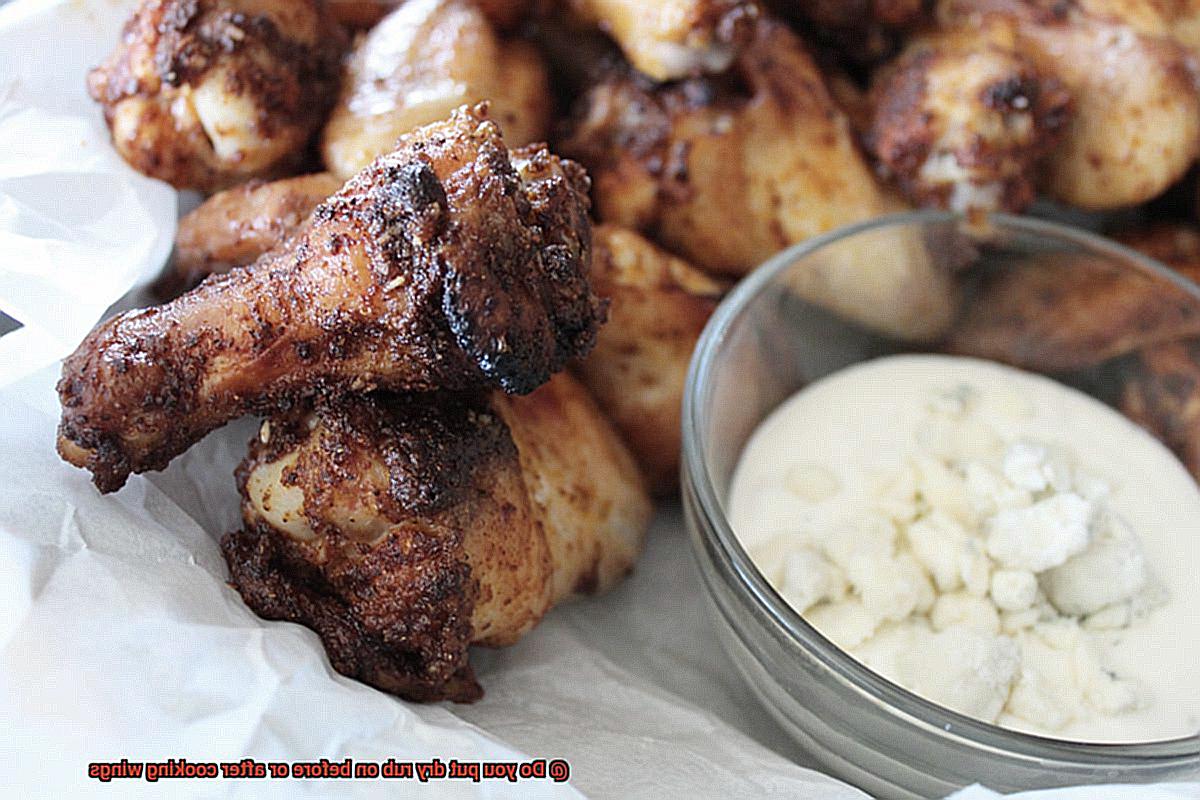
There are two major benefits to this method:
- No More Burnt Seasoning: Applying dry rub before cooking can be a risky move. The seasoning can easily char or burn during the cooking process, ruining the flavor and texture of your wings. By waiting until after they’re cooked, you eliminate this risk and ensure that your seasoning stays perfectly intact.
- More Precise Seasoning: Applying dry rub after cooking allows you to taste your wings and adjust the seasoning as needed. This gives you greater control over the flavor profile and ensures that each bite is packed with just the right amount of spice.
So, how do you apply dry rub after cooking? It’s easy. First, cook your wings until they’re fully cooked and crispy. Once they’ve cooled for a few minutes, place them in a large bowl and sprinkle your desired dry rub over them. Use your hands to toss the wings until they’re evenly coated.
When selecting a dry rub for your wings, consider flavors that complement chicken such as garlic, paprika, cumin, or chili powder. You can also experiment with sweet or savory options depending on your taste preferences. Remember, a little bit of dry rub goes a long way, so start with a small amount and add more as needed.
Advantages of Applying the Dry Rub After Cooking
Consider applying dry rub after cooking. This method has numerous advantages, and as an expert on the topic, I can confidently attest to its effectiveness.
One of the primary benefits of applying dry rub after cooking is that it allows the natural flavors of the meat to shine through. When seasoning is applied before cooking, it can overpower the taste of the meat, making it difficult to appreciate its unique flavor. But by waiting until after cooking, you can enhance the taste of the meat without masking it.
Another advantage of applying dry rub after cooking is that it helps create a deliciously crispy exterior. When seasoning is applied before cooking, it can clump together and become moist during cooking, resulting in a less crispy crust. However, by applying dry rub after cooking, you can achieve a beautiful crispy texture that perfectly complements the tender meat.
In addition to enhancing flavor and texture, applying dry rub after cooking also helps prevent burning or charring. When seasoning is applied before cooking, it can easily burn on the grill or in the oven, resulting in a bitter taste and tough texture. But by waiting until after cooking, you ensure that your meat is cooked evenly without any unsightly char marks.
Disadvantages of Applying the Dry Rub After Cooking
If so, you may be wondering whether to apply the rub before or after cooking. While it may seem like a great idea to add extra flavor and texture post-cooking, there are several disadvantages to this approach.
One of the major downsides of applying the dry rub after cooking is that it can result in uneven seasoning. As the rub is not cooked into the meat, it may not adhere as well and can easily fall off. This can leave some parts of the wings with little to no seasoning, while other parts may be overly seasoned. Not only does this affect the taste, but it can also make for an unsatisfactory eating experience.
Another issue with applying dry rubs after cooking is that it can create a dry and gritty texture. The rub simply sits on top of the wings instead of being absorbed into the meat, which can lead to a grainy and unpleasant mouthfeel. And if you’re planning to add sauce on top of your already seasoned wings, things can get even messier as the rub may become soggy and unappetizing.
Additionally, applying dry rubs after cooking can be a time-consuming and inconvenient process. It requires additional steps that can prolong the cooking process. It’s much more efficient to apply the dry rub before cooking so that it has time to penetrate the meat and enhance its flavor during the cooking process.
To sum up, while there are some benefits to applying dry rubs after cooking, such as adding extra flavor and texture, there are also several disadvantages that make it less than ideal. For best results, it’s recommended that you apply your dry rubs before cooking your wings so that they have time to properly absorb the flavors and create a deliciously seasoned result.
Finding Your Preference
The age-old debate of whether to apply dry rubs before or after cooking has sparked many a culinary discussion. But fear not, fellow foodies, as I’m here to guide you in finding your preferred method and achieving maximum flavor impact.
Let’s dive into the two main options: applying the dry rub before or after cooking. For those who crave bold, intense flavors and crispy exteriors, applying the dry rub before cooking is the way to go. This method allows the spices and seasonings to seep into the meat during cooking, resulting in a mouth-watering crust on the outside.
However, if you prefer more control over the level of seasoning and want to avoid overpowering flavors or burning, then applying the dry rub after cooking might be your style. This method lets you adjust the seasoning to taste and prevents it from becoming too intense during cooking.
Other factors that can influence your preference include cooking method (grilling vs baking), personal taste preferences, and the specific type of dry rub being used. Different blends may work better with one method over the other.
So how do you find your preferred method? Experimentation is key. Try both methods and pay attention to factors like flavor intensity, seasoning distribution, and texture. And don’t forget to let your wings sit with the dry rub for at least 30 minutes before cooking for maximum flavor absorption.
To ensure consistent flavor, it’s important to evenly distribute the dry rub over all parts of the wings. And remember, there’s no one “right” way to apply dry rub to chicken wings. It all comes down to personal preference and experimentation.
e6yZaY4IMPw” >
Conclusion
In the world of chicken wings, the question of whether to apply dry rub before or after cooking has sparked many debates among enthusiasts. While there are advantages and disadvantages to both methods, it ultimately boils down to personal preference.
When it comes to applying a dry rub, there are several factors that come into play. The texture of the rub, the cooking method, the type of rub being used, and your personal taste preferences all play a role in determining which method is best for you.
If you’re grilling or smoking your wings, applying the dry rub before cooking is recommended. This gives your rub ample time to form a mouth-watering crust on the outside of the wings and infuse them with a smoky flavor that will tantalize your taste buds.
On the other hand, if you’re baking or air frying your wings, it’s best to apply the dry rub after cooking. This ensures that your rub won’t burn or become too charred during the cooking process.
Regardless of which method you choose, remember that seasoning is an art form that requires experimentation. Try out different textures, cooking methods, types of rubs, and timing until you find the perfect combination that elevates your wings to new heights of deliciousness.

